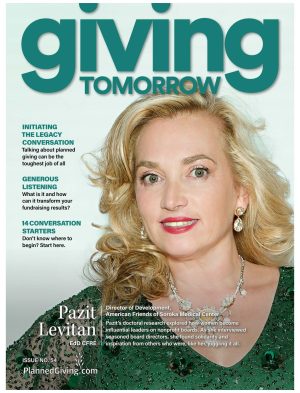Ready to kick-start your planned giving program? Here are six important facts you don’t want to ignore.
Your Prospects Don’t Want “Planned Giving” News.
The next time someone — a vendor, a board member, or another fundraiser — tells you that donors want a planned giving newsletter and that it will generate repeat traffic to your planned giving website by delivering “exciting” articles for your visitors to read, take it with a (very large) grain of salt.
Your planned giving website is not Time magazine, and your prospects will not visit your planned giving pages on a regular basis to read earth-shattering “planned giving” stories. Why? Because to the average civilian, there’s nothing “Earth shattering” about planned giving—it’s boring!
The fact is, maintaining monthly stories about planned giving is an unnecessary expense. A prospect will visit your website only once, twice, or maybe even three times over just a few days — not months — and then contact you. The site will always look fresh because the visit is short-lived. No one is going to regularly visit your site to read stories about CRUTs, CRATs, and tax-smart giving options. If you must have a newsletter, your best bet is to fill it with donor stories. Those will get read.
Planned Giving is not Fundraising.
It’s mostly marketing and sales. And marketing and sales takes people skills.
Your resources should be focused more on marketing and “sales” and less on learning and teaching how gift plans work. You might ask, “But what am I selling?” The answer: The mission and vision of your organization and the excitement and hope it provides. Help your prospects be part of that.
The fact is, you’re better off having ten prospects and not knowing how a lead trust is taxed, than having zero prospects and a Ph.D. in planned giving. (If you have both, the force is with you.)
Always keep the focus on getting the prospect in your door, or getting yourself in the prospect’s door. If you’re not an expert in the finer details of how specific planned gifts work, you can always hire the Ph.D.
Buying into the Hype Will Disappoint.
Are you laboring over minutiae, such as the pros and cons of an online planned giving calculator? Instead, look at the overall picture.
Are you binge marketing? Or, do you have proactive, steady marketing systems in place?
Are you investing in A.I. and hoping it will do all your writing for you? Genuine, human-written content is far more effective (and far less likely to offend or insult your supporters, too).
Are you buying into the media hype about a one-in-a-million e-marketing success story and putting all your efforts into digital? Or, do you have a balanced blend of print and electronic messages, all benefits-driven, short and to the point?
Remember, studies by the Direct Mail Association show that through all forms of media, your prospect is inundated with over 10,000 marketing and brand messages a day.
Promoting Planned Gift Details = Promoting the Negative.
Ferrari, Rolex, and American Express have one thing in common: they promote a lifestyle, and not the features of their products.
You should be using the same principle with planned giving.
If you’re always attending the next seminar on gift annuities or on how a unitrust works, you might as well learn how to sell cemetery plots. Focusing on those types of details is essentially promoting your prospect’s death — and who wants to hear about that?
Your marketing should be benefits- and results-driven, not features-driven; you want to sell the sizzle, not the steak. When you boil it all down, the features of planned gifts revolve around death. Their benefits and long-term results, however, promote immortality. Features slow down your sales process. Benefits sell the sizzle. Selling the sizzle keeps your prospect’s mind focused on your mission, vision, and on making the gift. It’s that simple.
Mission-Driven Marketing Plays to Your Strengths.
Consider the following: The big players in the finance industry give investment advice — and turn profits — better than anybody else. So when you send “canned” investment brochures to your prospects, you’re competing with the mega-financial institutions and their beautiful informational materials, and on their home turf, too. Does that make sense?
Your institution possesses a unique advantage over financial and investment giants, because it’s not just a retail investment-profit generator. Your organization already has a special relationship with its prospects because of the good you do.
You can harness the power of this relationship with mission-driven messages. Update supporters on your progress. Highlight an outstanding donor or volunteer. Focus on the human element, not the financial one.
Mixed-Media Marketing Works Best.
Successful nonprofits and for-profits use mixed media to communicate with their prospects. Translation: don’t use just emails to spread your message. Use cards, letters, display ads, and (gosh!) even the old-fashioned phone.
If you stick to one single medium (such as emails), your prospects will tune you out. (Savvy direct marketers in other fields know this well.) The goal of all these tools is getting face-to-face visits – because the human moment as the Harvard Business Review points out is critical. Begin with these simple, 10 planned giving marketing strategies.
And remember, sell the sizzle (vision, benefits and results), not just the steak (features).
Want more tips? Here are some fun facts, figures, answers and solutions you’ll love: Plannedgiving.com/answers/






